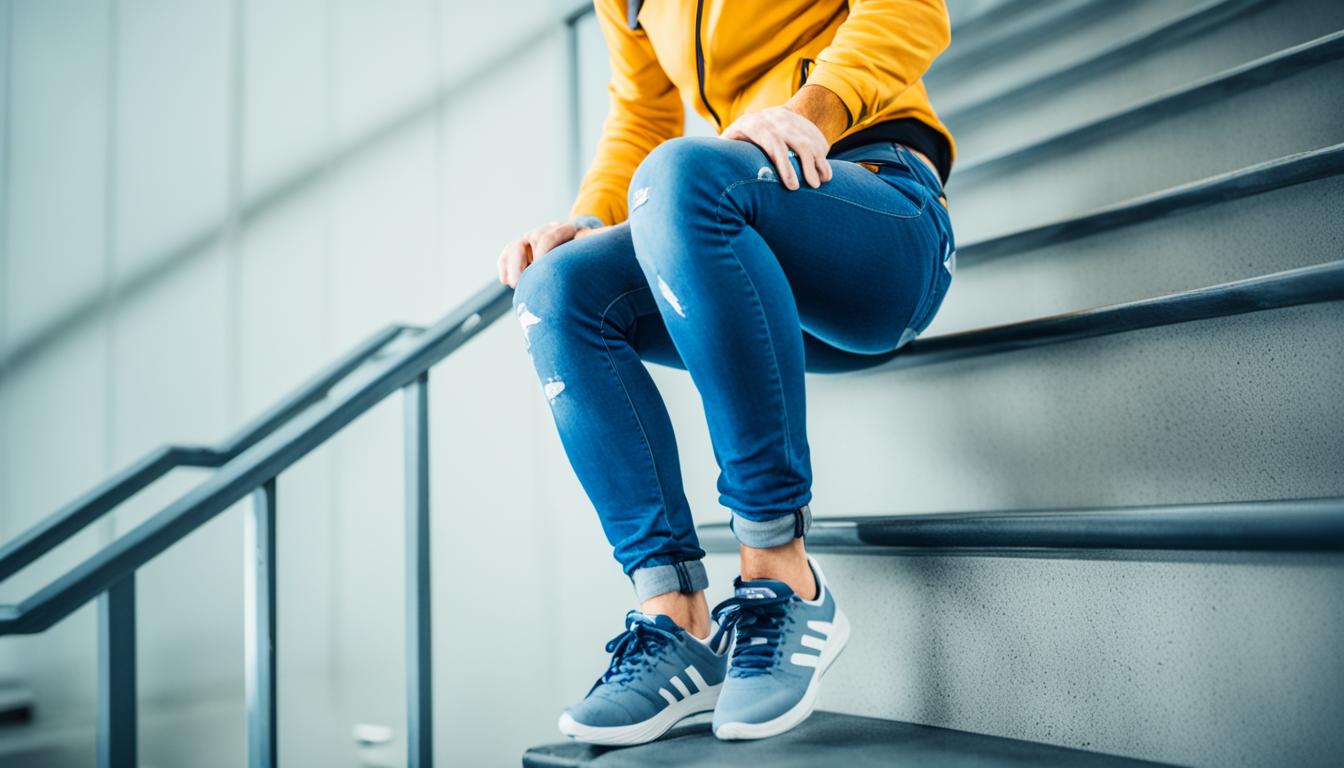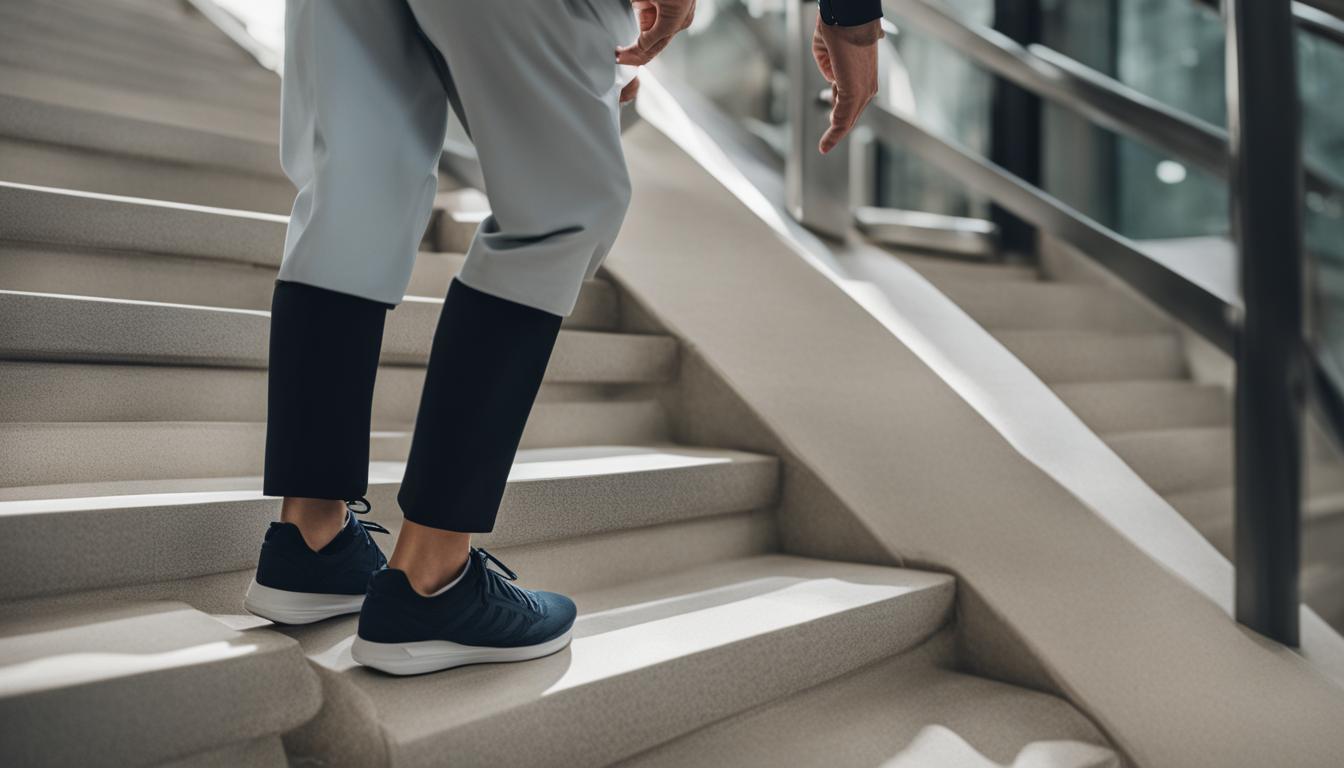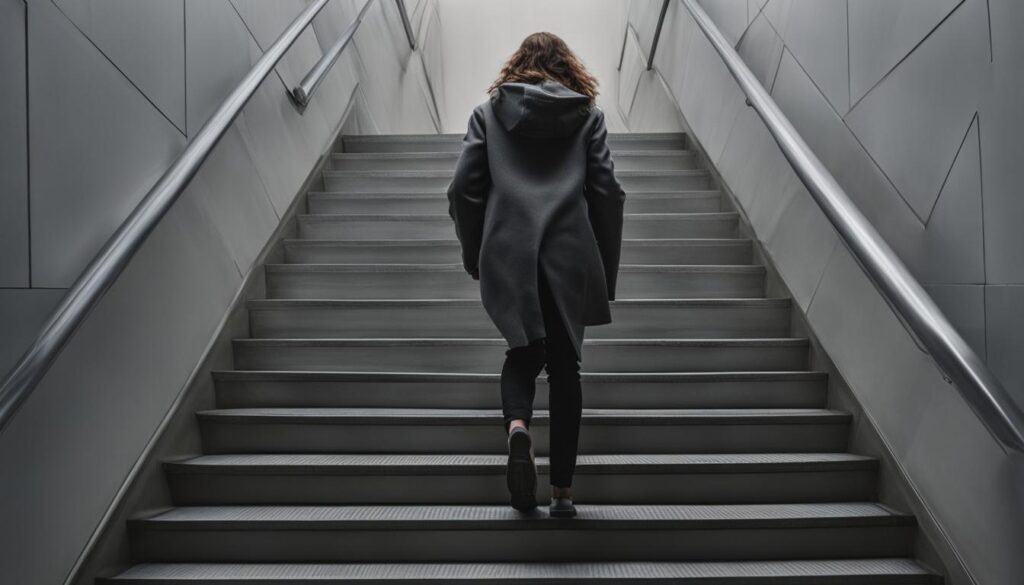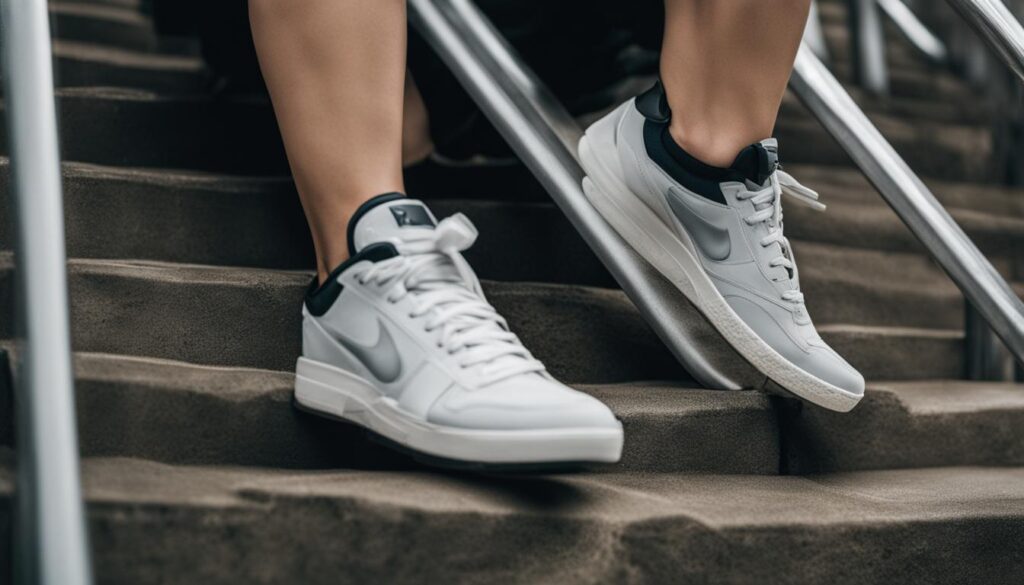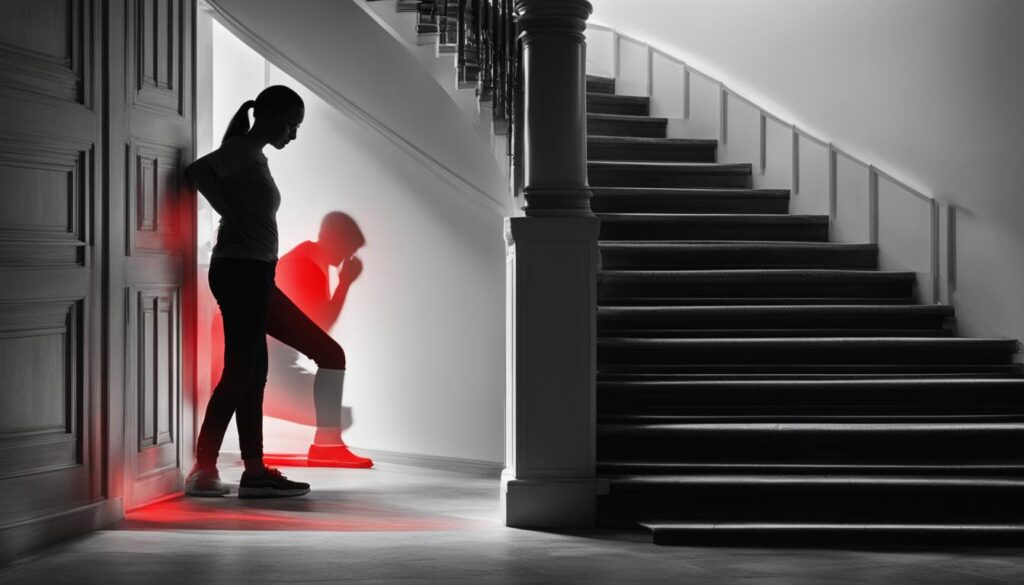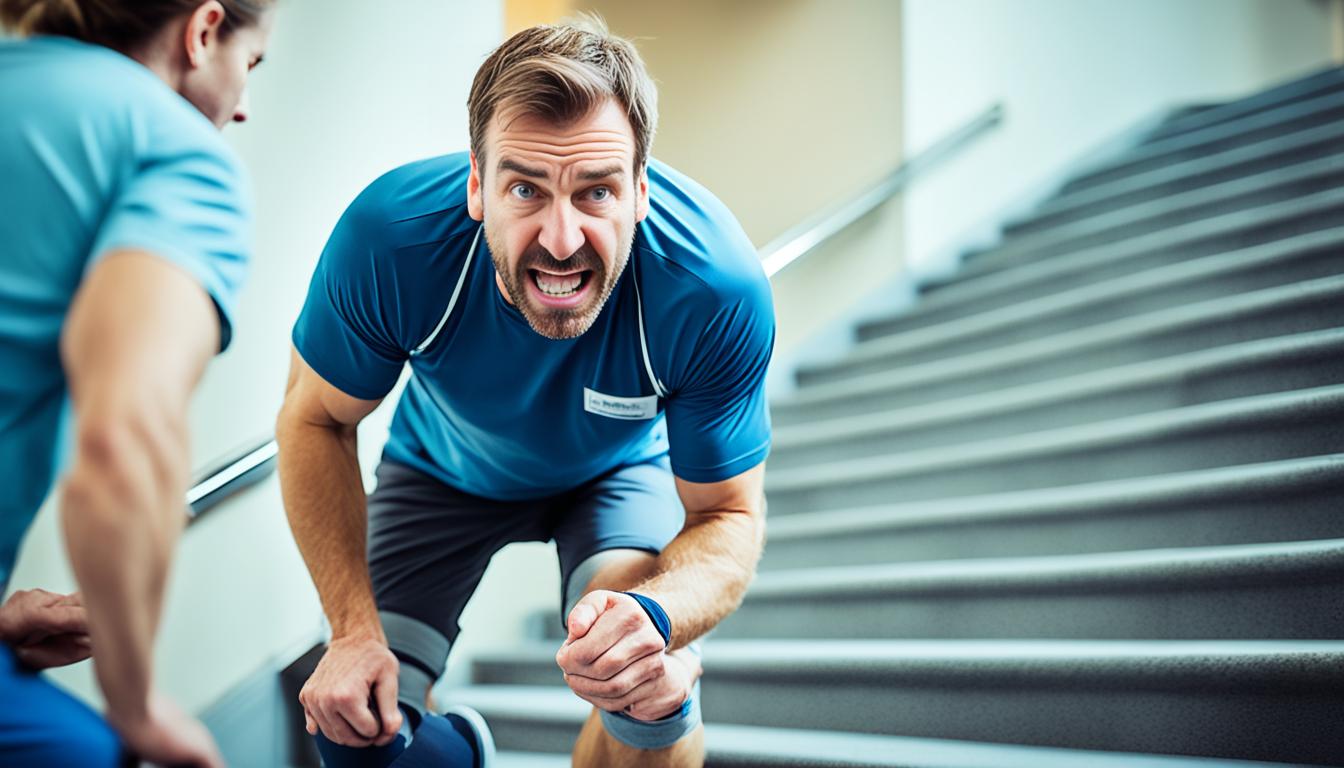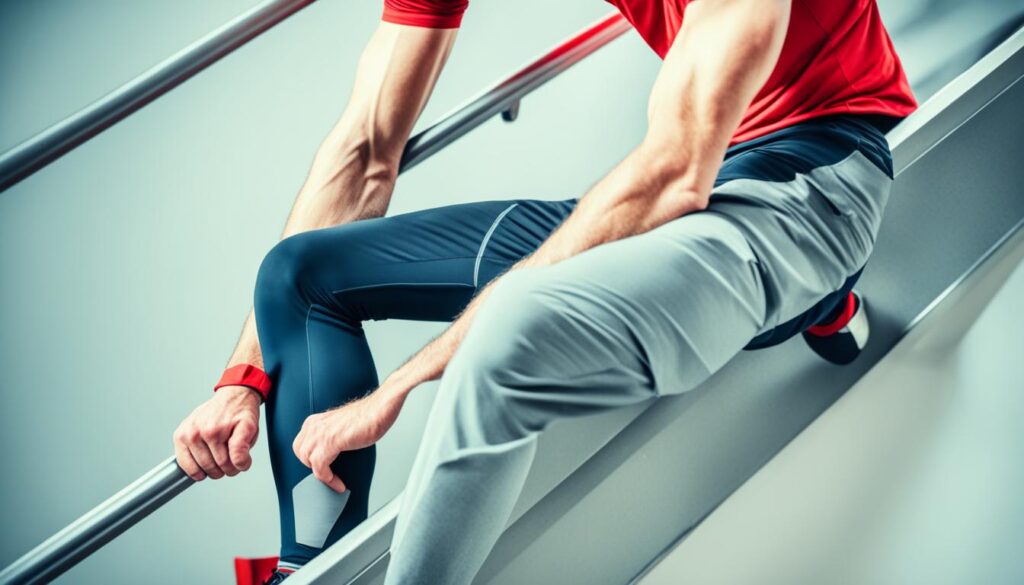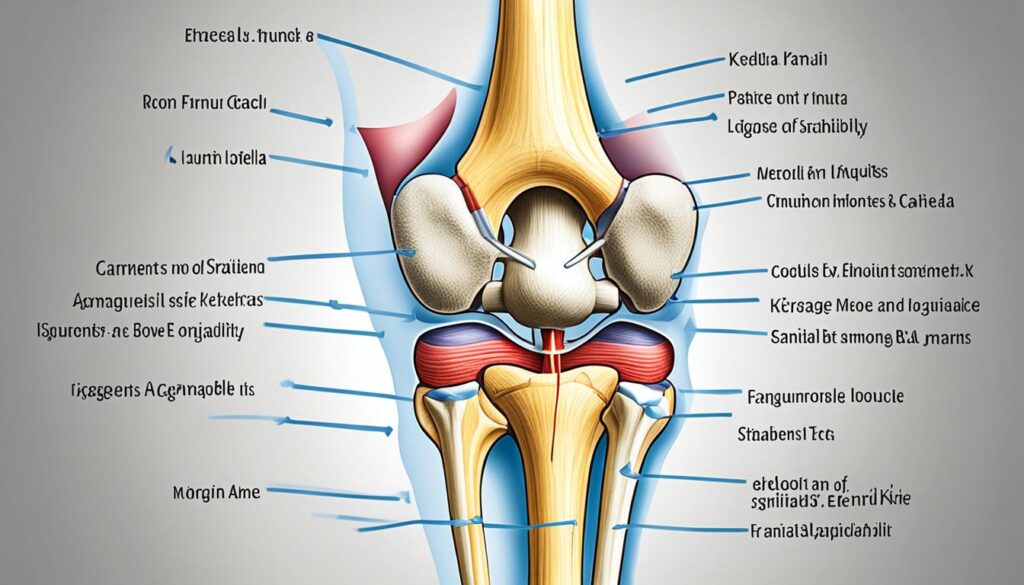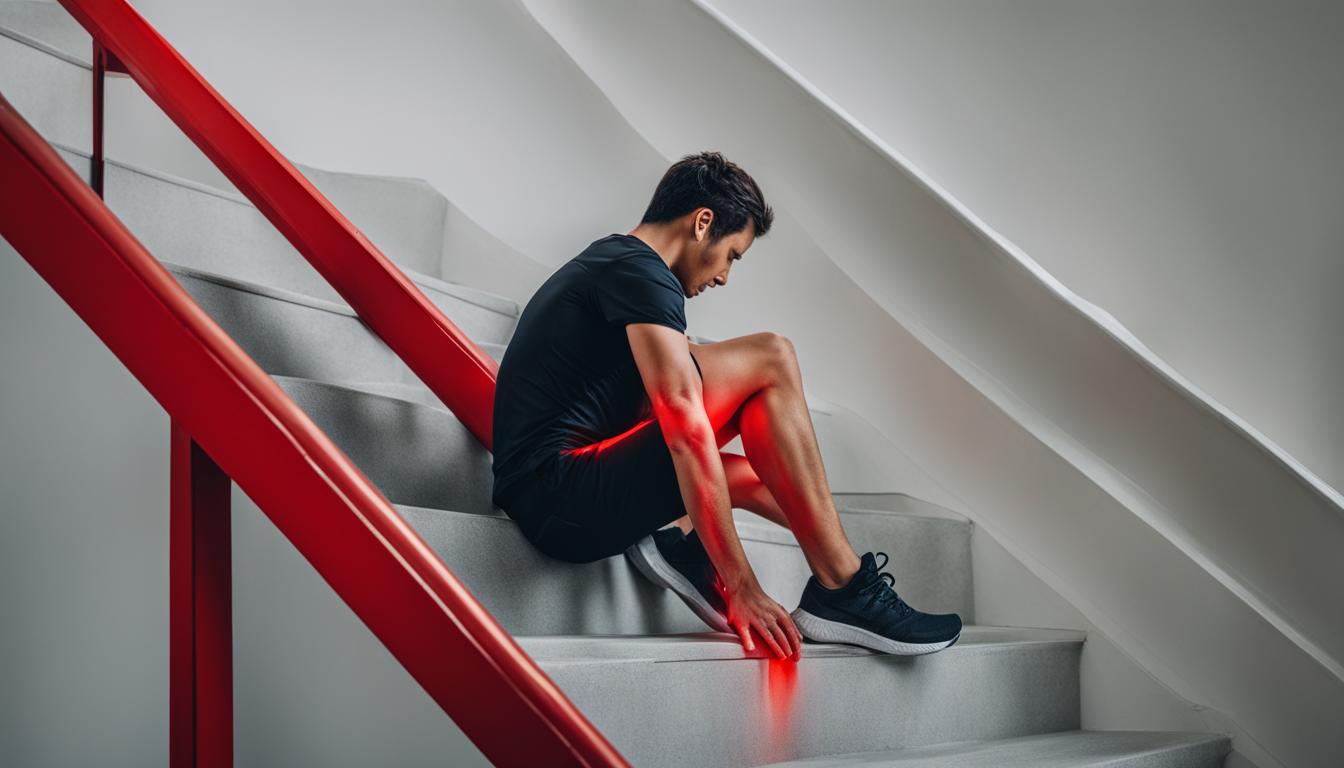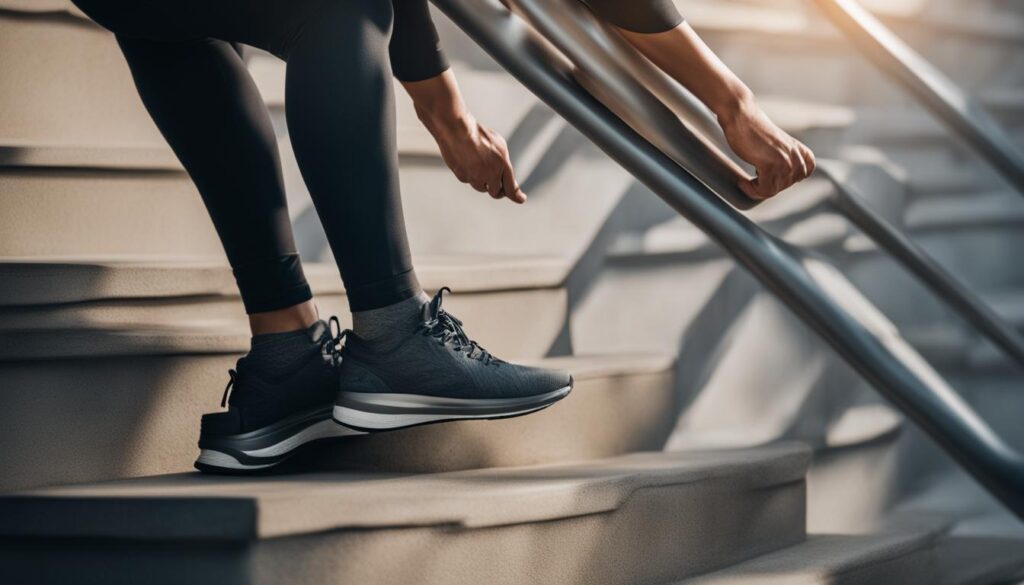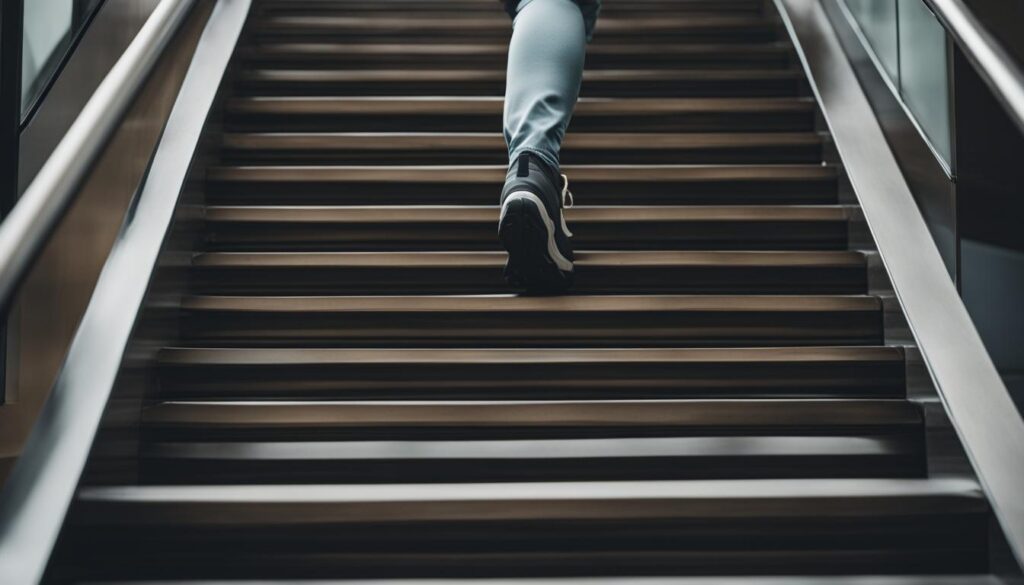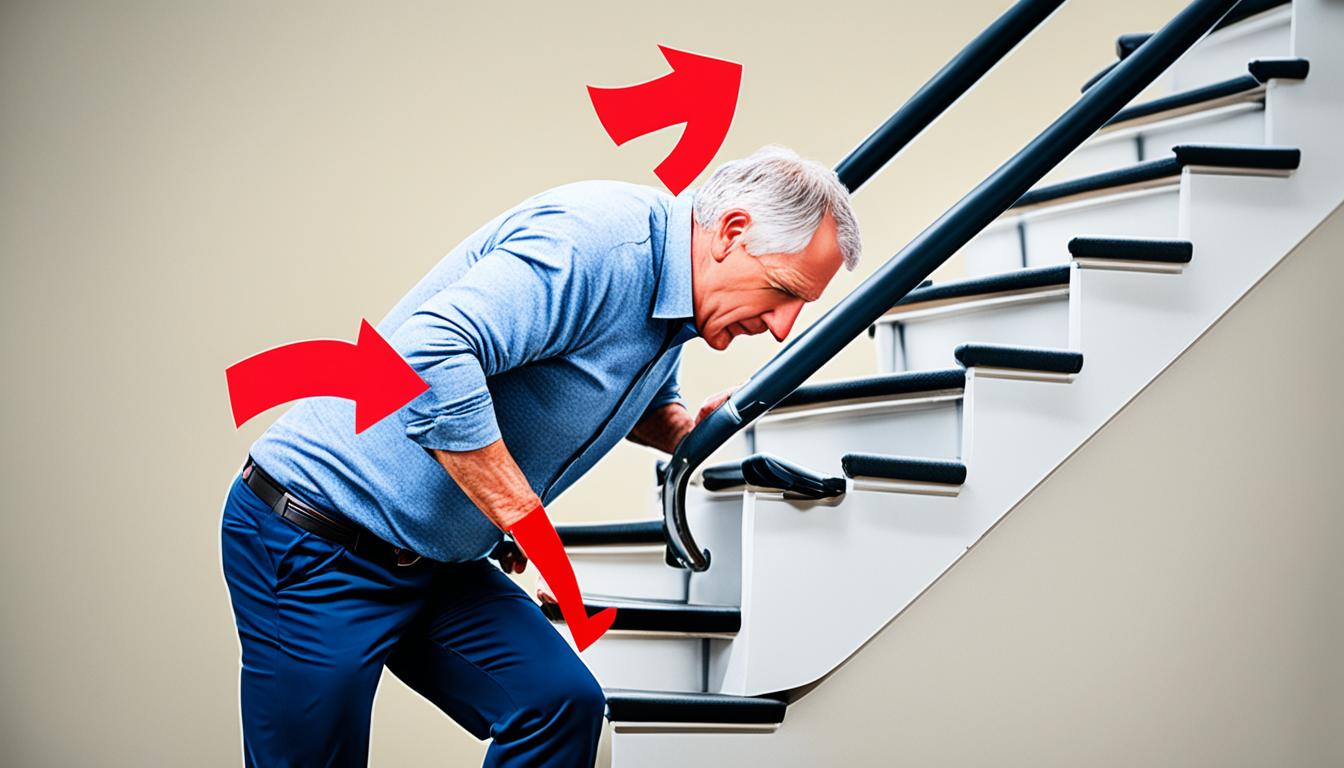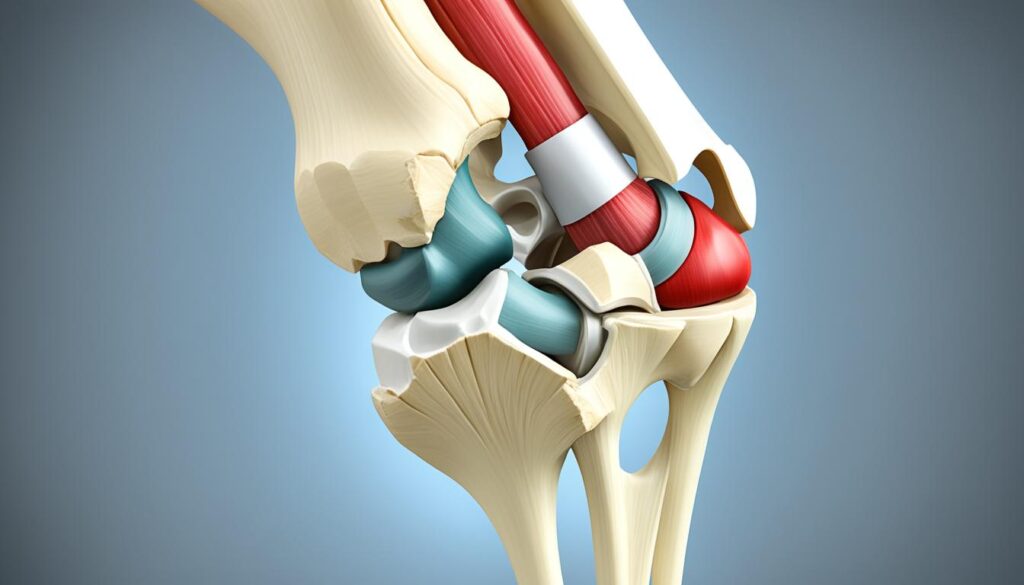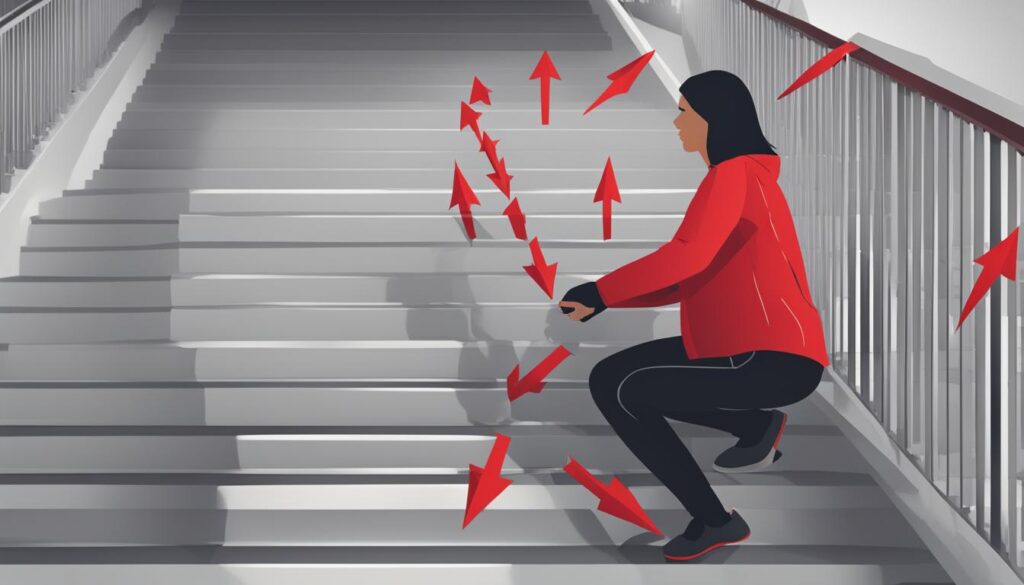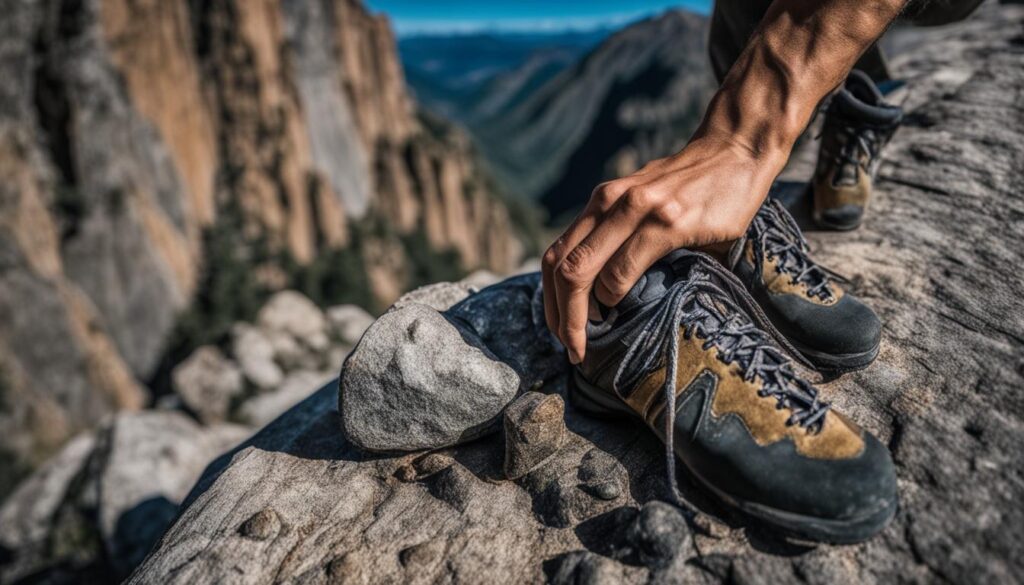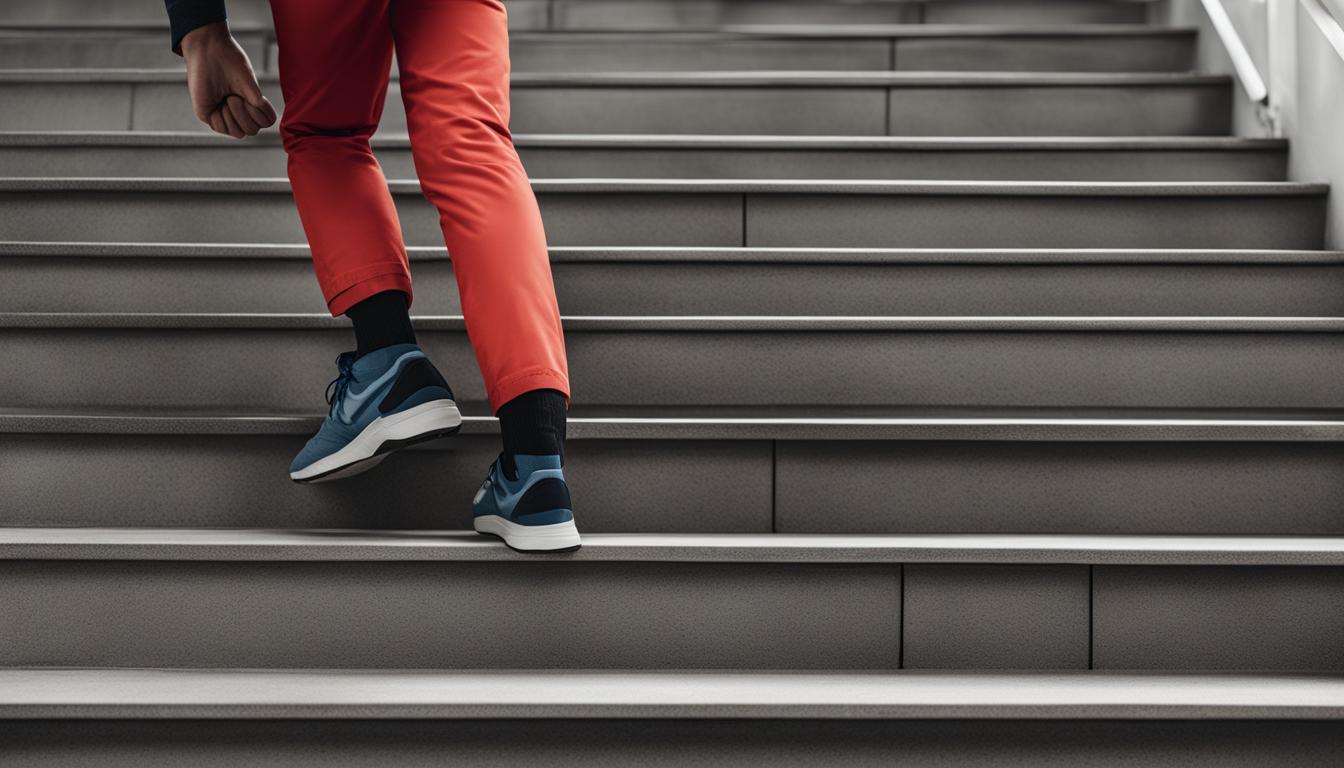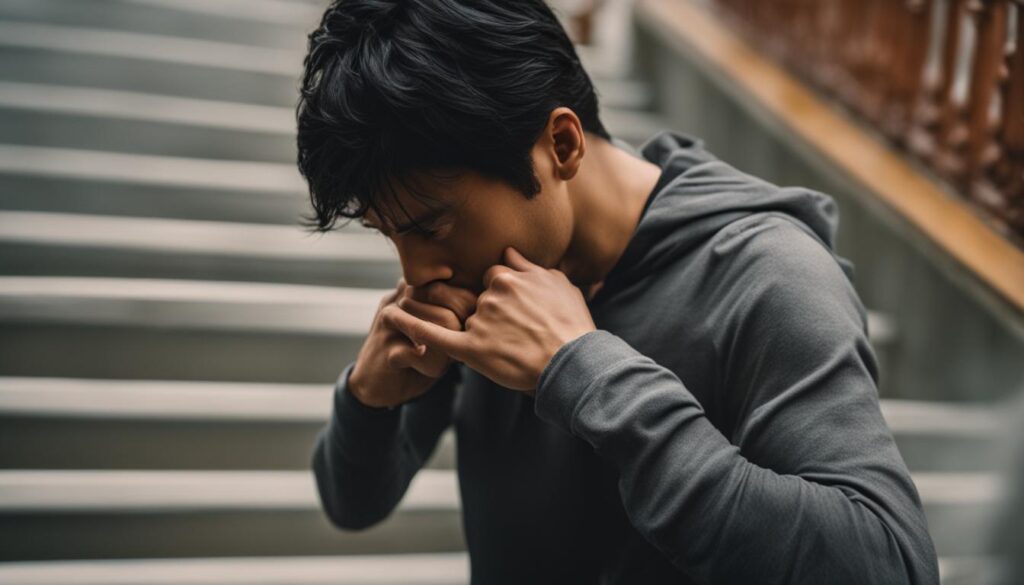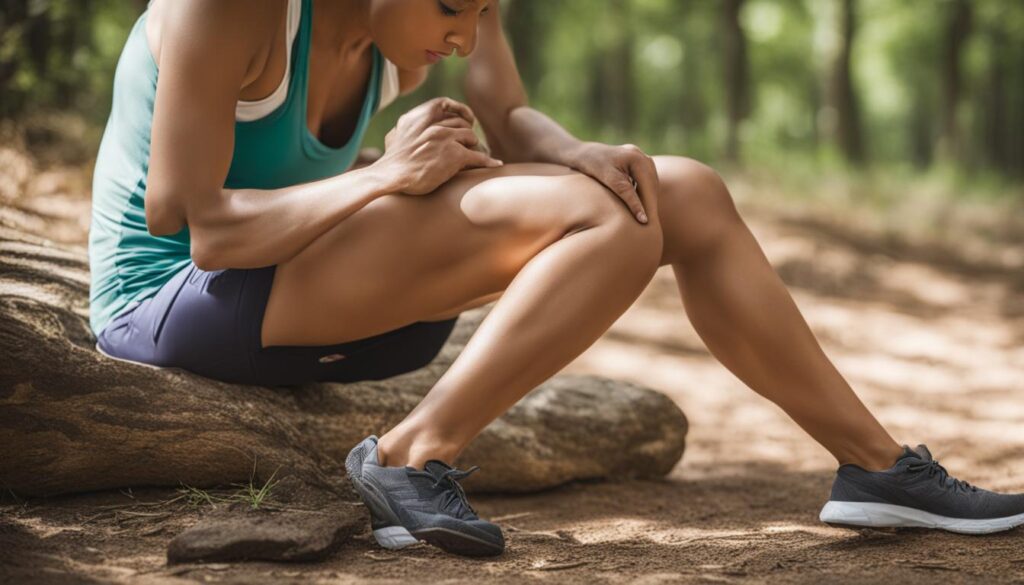Are you experiencing knee pain when walking up stairs? You’re not alone. Many individuals encounter discomfort and strain in their knees when ascending steps. This can make simple everyday tasks, like climbing stairs, challenging and painful.
When you walk up stairs, the pressure exerted on your knees can be three to six times your body weight. This increased load can lead to knee pain and discomfort, making it difficult to perform this basic movement without discomfort.
There could be several reasons why your knee hurts when climbing stairs. Common causes include patellofemoral pain syndrome, meniscus tears, chondromalacia patella, IT band syndrome, and muscle imbalance. Understanding the underlying cause of your knee pain is crucial in finding the right solutions.
Key Takeaways:
- Walking up stairs can put significant pressure on your knees, leading to pain and discomfort.
- Several factors can contribute to knee pain when going up stairs, including patellofemoral pain syndrome, meniscus tears, chondromalacia patella, IT band syndrome, and muscle imbalance.
- Targeted exercises, body awareness techniques, and modifications in walking technique can help alleviate knee pain on stairs.
- Understanding the anatomy and function of the knee is essential in comprehending the causes and potential treatments for knee pain when walking up stairs.
- Treating and managing knee pain on stairs often involves a combination of targeted exercises, physical therapy, and home remedies.
Understanding Knee Anatomy and Function
When it comes to knee pain, understanding the anatomy and function of the knee joint is crucial. The knee joint consists of various structures that work together to provide stability and facilitate movement. These structures include:
- Bones: The knee joint is formed by the articulation of three bones – the patella (kneecap), femur (thighbone), and tibia (shinbone). These bones provide support and form the framework of the knee.
- Ligaments: The knee is supported by collateral and cruciate ligaments. The collateral ligaments (medial and lateral) provide stability by preventing excessive sideways movement, while the cruciate ligaments (anterior and posterior) control forward and backward motion of the knee.
- Tendons: Tendons connect the muscles to the bones and enable the knee to move. The quadriceps tendon connects the quadriceps muscle to the patella, and the patellar tendon connects the patella to the tibia.
- Cartilage: The knee joint is lined with articular cartilage, a smooth tissue that enables smooth gliding of the bones during movement, reducing friction and providing cushioning.
- Menisci: The knee contains two crescent-shaped cartilage discs called menisci. They act as shock absorbers and provide stability by improving the fit between the femur and tibia.
- Bursae: Bursae are small fluid-filled sacs located throughout the knee joint. They reduce friction between the bones, tendons, and ligaments, allowing smooth movement.
- Muscles: The muscles surrounding the knee, such as the quadriceps, hamstrings, and calf muscles, play a vital role in supporting and moving the knee joint.
- Nerves: Nerves in the knee joint provide sensation and control the muscles involved in knee movement, allowing for coordination and proprioception.
By understanding the intricate interplay of these structures, we can gain insights into the causes of knee pain when walking up stairs and explore effective treatment options to alleviate discomfort.
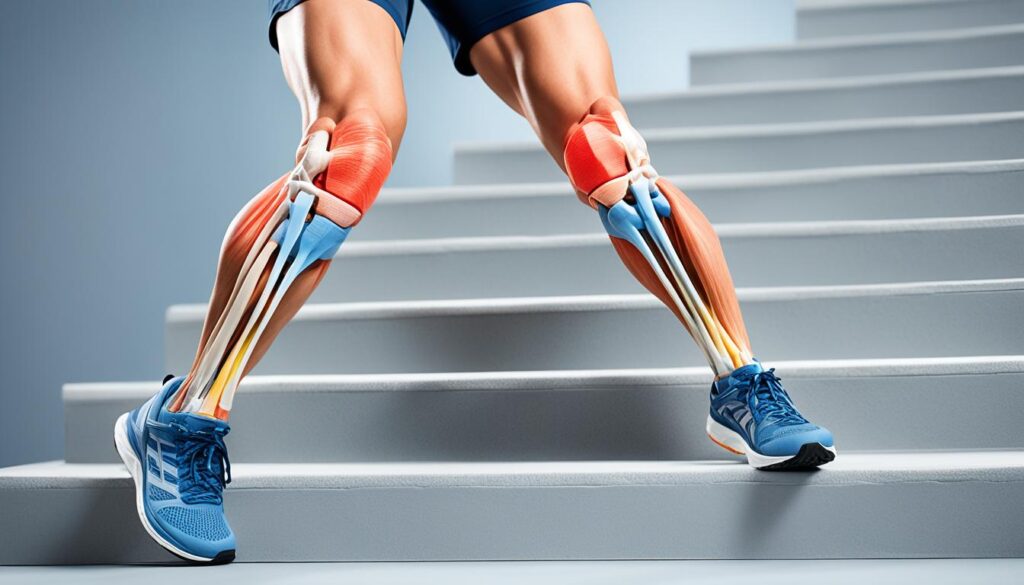
Common Causes of Knee Pain on Stairs
When walking up stairs, knee pain can be attributed to several common causes. These include:
- Patellofemoral Pain Syndrome: Also known as “runner’s knee,” this condition is often caused by overuse or a sudden increase in physical activity.
- Meniscus Tear: Trauma or age-related degeneration can lead to a tear in the meniscus, a cartilage in the knee joint.
- Chondromalacia Patella: This condition involves the softening and breakdown of the cartilage behind the kneecap, resulting in knee pain.
- IT Band Syndrome: When the iliotibial band becomes irritated due to repetitive movement, it can cause discomfort and pain in the knee.
- Muscle Imbalance: Quad dominance and muscle imbalances can put strain on the knee joint, leading to pain while climbing stairs.
Understanding the specific cause of knee pain is crucial in determining the appropriate treatment and management strategies. Consulting with a healthcare professional can provide a proper diagnosis and guidance for addressing knee pain on stairs.
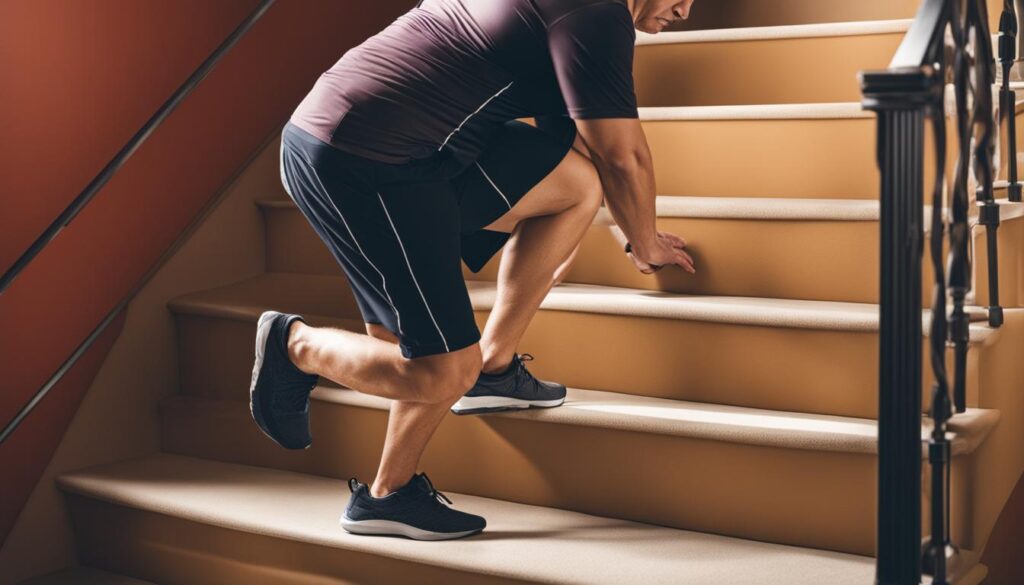
Note: The image above illustrates the common causes of knee pain on stairs.
Treating and Managing Knee Pain on Stairs
When it comes to knee pain when walking up stairs, there are various treatment options available to alleviate discomfort and help you regain mobility. These treatments focus on targeted exercises, body awareness techniques, walking techniques, physical therapy, and home remedies.
Targeted Exercises
One effective approach to manage knee pain on stairs is through targeted exercises. These exercises aim to strengthen the knee and the muscles surrounding it, providing greater support and stability. Some examples of targeted exercises for knee pain relief include:
- Lunges
- Squats
- Leg lifts
- Hamstring curls
Body Awareness Techniques
Improving body awareness can help reduce strain on the knee and improve movement patterns. By focusing on optimal body alignment and posture, you can enhance the efficiency and effectiveness of your movements. Building body awareness can be achieved through exercises and activities such as yoga, Pilates, and balance training.
Walking Technique
Modifying your walking technique can also provide relief from knee pain on stairs. By adopting proper walking mechanics, you can reduce the stress and impact on your knees while ascending or descending stairs. Some techniques to consider include:
- Using a handrail for support
- Consciously engaging specific muscles while climbing stairs
- Placing your feet correctly and distributing your weight evenly
Physical Therapy
For personalized treatment plans and expert guidance, consulting a physical therapist can be highly beneficial. A physical therapist will assess your condition, identify underlying causes of knee pain, and design a comprehensive treatment program tailored to your specific needs. Physical therapy may involve a combination of exercises, manual techniques, and modalities to alleviate pain and improve knee function.
Home Remedies
Alongside targeted exercises and professional assistance, there are home remedies that can help manage knee pain on stairs. These remedies can be easily incorporated into your daily routine and provide relief when needed. Some effective home remedies include:
- Using ice or cold packs to reduce inflammation
- Taking over-the-counter pain medication, such as ibuprofen or acetaminophen
- Wearing supportive footwear to provide cushioning and stability
By combining targeted exercises, body awareness techniques, walking technique modifications, and utilizing home remedies, you can effectively treat and manage knee pain when walking up stairs. However, it’s important to remember that every individual is different, and what works for one person may not work for another. If your knee pain persists or worsens, seeking professional medical advice is highly recommended for a proper diagnosis and personalized treatment plan.
How to Reduce Knee Pain on Stairs
Reducing knee pain when walking up stairs can be achieved through practical strategies that minimize strain and provide support to the knee. By following these techniques, you can alleviate discomfort and make stair climbing more manageable.
1. Take one step at a time and lead with the correct leg
When ascending stairs, take it slow and focus on taking one step at a time. This approach reduces the strain on your knees and allows for better control. Additionally, be mindful of leading with the correct leg, which helps distribute the weight evenly and minimizes the load on the affected knee.
2. Use handrails or crutches/sticks for support
Using handrails or crutches/sticks can provide additional support and stability while climbing stairs. These aids help distribute your weight and reduce the impact on your knees, relieving pain and discomfort.
3. Warm up the knee before stair climbing
Before tackling a flight of stairs, it’s essential to warm up your knee joints. Perform gentle stretches and mobility exercises to improve blood flow, loosen up the muscles and joints, and alleviate any stiffness or discomfort.
4. Improve strength through targeted exercises
Strengthening the muscles around your knees is crucial in providing better support and reducing pain. Incorporate exercises like sit-to-stand and step-ups into your routine to improve the strength and stability of your knee joint. Consult with a physical therapist or fitness professional for personalized recommendations.
By implementing these strategies, you can actively reduce knee pain on stairs, making daily activities more manageable and enjoyable.
Preventing Knee Pain on Stairs
To prevent knee pain when walking up stairs, it is essential to incorporate various lifestyle factors into your routine. By focusing on weight management, proper footwear, muscle strengthening, warm-up and cooldown exercises, and avoiding repetitive stress on your knees, you can significantly reduce the risk of experiencing knee pain.
Achieve and Maintain a Healthy Weight
Excess weight can put additional stress on your knees, leading to discomfort and pain when climbing stairs. By maintaining a healthy weight through a balanced diet and regular exercise, you can reduce the load on your knee joints and alleviate strain.
Choose Proper Footwear
Wearing shoes with good support and cushioning is crucial in providing stability and shock absorption while climbing stairs. Invest in well-fitted, comfortable shoes specifically designed for activities that involve stairs, such as walking or hiking.
Engage in Muscle Strengthening Exercises
Strengthening the muscles around your knees can enhance joint stability and protect against knee pain. Incorporate exercises that target the quadriceps, hamstrings, and glutes into your fitness routine. Consult with a healthcare professional or a certified trainer to develop a muscle-strengthening program tailored to your needs.
Warm-Up and Cooldown
Prior to stair climbing or any physical activity, it is important to warm up your muscles and prepare your joints for movement. Engage in dynamic stretching exercises that focus on the lower body to increase blood flow and improve flexibility. Afterward, include a cooldown period to gradually reduce your heart rate and allow your muscles to recover.
Avoid Repetitive Stress on Your Knees
Repetitive stress on your knees, such as excessive stair climbing or activities that involve pivoting or twisting, can lead to knee pain. Be mindful of your activity levels and vary your workouts to avoid overusing your knees. Incorporate low-impact exercises like swimming or cycling into your fitness routine to give your knees a break.
| Tips for Preventing Knee Pain on Stairs | |
|---|---|
| Weight Management | Maintain a healthy weight to reduce stress on your knees. |
| Proper Footwear | Wear shoes with good support and cushioning to provide stability and shock absorption. |
| Muscle Strengthening | Engage in exercises that target the muscles around your knees for improved joint stability. |
| Warm-Up and Cooldown | Always warm up before physical activity and cool down afterward to prepare your muscles and joints. |
| Avoid Repetitive Stress | Avoid excessive stair climbing and activities that strain your knees repeatedly. |
Conclusion
Dealing with knee pain when walking up stairs can be both frustrating and debilitating, but there are effective solutions to find relief and manage this condition. By understanding the underlying causes of knee pain, implementing targeted exercises, and making necessary lifestyle modifications, individuals can alleviate discomfort and promote better knee health.
To relieve knee pain on stairs, it is crucial to engage in appropriate exercises that strengthen the surrounding muscles and provide better support to the knee joint. By working with a healthcare professional, such as a physical therapist, individuals can learn specific exercises tailored to their needs and condition.
In addition to exercises, it is essential to pay attention to proper techniques when climbing stairs. Taking it one step at a time, leading with the correct leg, and using handrails for support can all help reduce strain on the knees. By incorporating these stair climbing tips into daily routines, individuals can minimize stress on their knees and prevent further discomfort.
Remember, maintaining good knee health is a lifelong commitment. In addition to targeted exercises and proper techniques, adopting a healthy lifestyle that includes weight management, wearing proper footwear, and avoiding repetitive stress on the knee can all contribute to better knee health and long-term knee pain management. With these strategies in place, individuals can continue to navigate stairs with less pain and live an active and fulfilling life.
FAQ
Why does my knee hurt when walking up stairs?
Walking up stairs can cause knee pain due to the increased pressure exerted on the knee joint, which can be three to six times your body weight. This pressure can lead to strain and discomfort, especially if there are underlying issues such as patellofemoral pain syndrome, meniscus tears, chondromalacia patella, IT band syndrome, or muscle imbalance.
What are the common causes of knee pain when walking up stairs?
Knee pain on stairs can be caused by various factors. Some common causes include patellofemoral pain syndrome (runner’s knee), meniscus tears, chondromalacia patella (softening of the cartilage behind the kneecap), IT band syndrome, and muscle imbalance, particularly quad dominance.
How can knee pain on stairs be treated and managed?
There are various treatment options for knee pain on stairs. Targeted exercises can help strengthen the knee and surrounding muscles to alleviate pain. Body awareness techniques and modifications in walking technique can also provide relief. Physical therapy can be beneficial for personalized treatment plans, and home remedies like using ice and over-the-counter pain medication can help manage symptoms.
What are some practical strategies to reduce knee pain when walking up stairs?
To reduce knee pain on stairs, you can try taking one step at a time and leading with the correct leg to minimize strain. Using handrails or support devices like crutches or sticks can distribute weight and reduce impact on the knee. Warming up the knee before stair climbing and engaging in strength exercises like sit-to-stand and step-ups can also provide better support for the knee joint.
How can I prevent knee pain on stairs?
Preventing knee pain on stairs involves maintaining a healthy weight to reduce stress on the knee joint. Wearing proper footwear with good support can provide stability and cushioning. Engaging in muscle-strengthening exercises can improve knee stability, and proper warm-up and cooldown exercises before and after physical activity can reduce strain. It’s also important to avoid repetitive stress on the knee, such as excessive stair climbing or activities that involve pivoting or twisting.
